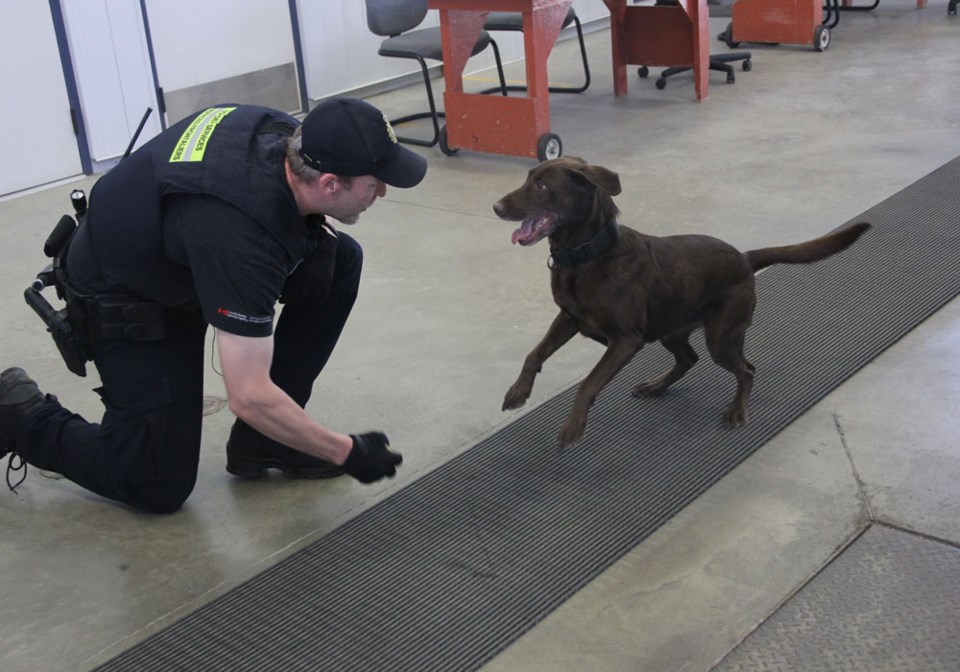
A brown lab is given a tennis ball as a reward for her previous efforts, which had nothing to do with sitting down or shaking a hand. Instead, she discovered drugs in a car.
She then runs around the vehicle, smiling widely while clenching the ball between her teeth. Her handler Toban Tisdale explains to reporters watching the exercise unfold that she’s performing a victory lap.
“She’s crazy,” Tisdale said. “Crazy dogs make the best detector dogs, and we want to use that crazy energy and have them focus on the task at hand.”
Nine-year-old detector dog Holly was one of the main attractions during an open house at the Canadian Border Services Agency in North Portal on May 20, and though the car Holly thoroughly checked for drugs was only a test, it closely mirrored the real-life scenarios Holly has faced countless times for the past eight years as a detector dog.
“She’s done hundreds of seizures over the years,” said Toban Tisdale, a detector dog handler who has been with the CBSA since 2001 and with Holly since 2008.
The dynamic duo patrols border crossings and airports across Saskatchewan, looking for drugs and weapons. Holly is two years away from retirement.
“She’s trained to detect narcotics as well as firearms,” Tisdale said. “Everything has an odour and a dog’s nose is about 10,000 times more powerful than a human’s nose.”
To put that into perspective, Tisdale walks the group into a small warehouse room filled with various boxes and other items. Tisdale yells “Search” and Holly becomes a blur as she scours the room with her nose to the ground looking for contraband.
“In this room, she can probably small each individual item’s odour,” Tisdale said.
A few minutes later, Holly sits down, indicating to her handler that she has found something. A small baggie sits on the ground in front of her. Once again, Holly gets the tennis ball as a reward.
Tisdale said daily training keeps Holly on her toes and prepares her for more intense searches.
“I can take her to an airport with hundreds of people and she won’t be scared. She’s actually kind of shy,” Tisdale said with a smile.
His love for dogs – Tisdale has two, three including Holly – was a big reason why he decided to join the CBSA in 2001.
“We talk to people all day, we interview them, we look at their stuff and I get to play with a dog,” he said. “To me, it’s a dream job.”
It’s also a dream job for Holly, who has earned three Detector Dog Champion awards at the Police Canine Association’s annual trials, where she competed against dogs from across the country that work in corrections, protection and policing.
A 10-week training course at the CBSA college in Ottawa is required for dogs to enter the field of detector dogs. Few make the cut.
“To her, it’s just a game,” Tisdale said in reference to Holly’s ultra-keen senses. “It’s not a job to her, she’s just having fun.”
The fun comes with an extremely busy schedule, however, as the two are on call 24 hours a day. The pair can be called in when officers believe a traveler is hiding contraband, even when Tisdale and Holly aren’t conducting their regular shifts.
At this point, Holly is smart enough to understand when she’s practising her searching skills and when she’s in a live environment, so CBSA staff have to keep her drive up and push the dog frequently by hiding things that are harder for her to find.
CBSA officer Curtis Barry said it’s important for Holly to train hard because the smuggling community grows more creative every day.
“The smuggling community is getting to be more sophisticated, of course,” said Barry. “You come across false traps, we call them, as far as people actually building compartments after market and using them for the purposes of smuggling.
“They’re exciting to find,” he added. “There’s no question about it.”
Tisdale stressed the fact that Holly is solely a detector dog and never assumes the role of an attack dog.
“We don’t need our dogs to pursue people and attack them. We just use them to find the drugs and weapons.”




